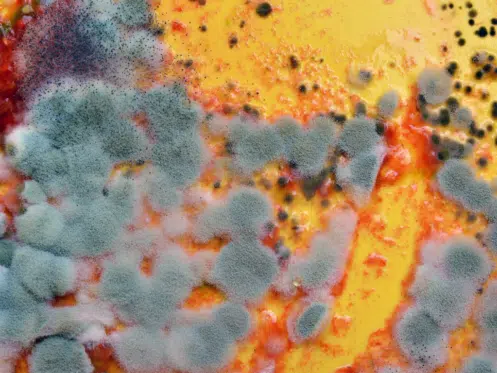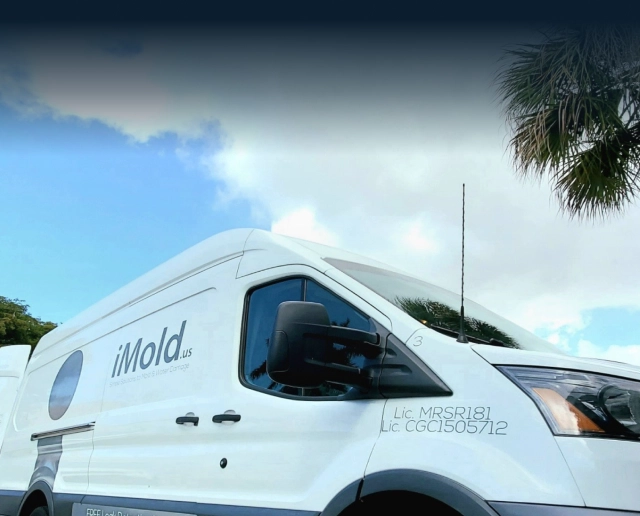With over 100,000 different types of mold, (not all will be found indoors), mold can come in so many colors and textures that it’s almost impossible to identify it just by sight. Even mold experts will send samples for testing to determine the specific type of mold they’re dealing with. Many molds found in nature are beneficial to decomposition, but what makes them helpful outside causes damage to homes and buildings.
Most Common Types of Mold in Homes
The purpose of this list is purely informative. In no way does it contain every mold ever found inside. Even the Centers for Disease Control states that there is no definitive information about how often each mold type is found in buildings since it can frequently go undetected, untested, and untreated. If you have any questions about mold types, be sure to consult an expert.
Aspergillus
This is one of the most commonly found molds found in homes. Because it can feed on everything from dust to wallpaper and carpet, aspergillus affects many buildings in Florida. Like many other mold types, it’s dangerous due to its health effects that range from allergy-like symptoms to respiratory infections. It’s difficult to identify by sight alone because its colors can vary.
Aureobasidium
Another common mold, Aureobasidium also varies in color because it’s one genus of mold that has several species. The color and texture can even change during its lifecycle, requiring special testing to identify. It thrives in warm, humid environments as we have in Florida, meaning it’s often found in kitchens, bathrooms, laundry rooms, and other areas prone to dampness.
Cladosporium
While some types of mold prefer precise temperatures, Cladosporium doesn’t discriminate, making it one of the most commonly found molds throughout the country. Like other molds on the list, it eats its way through your home’s drywall, flooring, and even your curtains. You’re probably noticing a pattern in the health effects, as well; Cladosporium can cause skin irritation, rashes, respiratory issues, and other common mold side effects.
Penicillium
Similar to Aspergillus, penicillium is very common and can cause adverse health effects. Although it can be used in medicine production, it’s not something that you want growing inside your home. Its primary food source is your home itself, whether that’s the building materials or decorations.
Stachybotrys
This mold type is probably the most well-known on the list. Also known as black mold, Stachybotrys is as common as it is hazardous. Many people know that black mold is toxic since its health effects are far more severe than other types of commonly found mold. It can cause everything from skin rashes to confusion just by breathing in its spores, making it extremely dangerous. However, just because you see some black mold doesn’t mean it’s Stachybotrys. It often looks identical to other mold types, so always proceed with caution once you see mold inside.
How Does Mold Get Inside?
So, now that you’ve learned a little about some common mold types, how did they get there? There are several causes of mold in homes, some more obvious than others. Because Southwest Florida has significantly higher humidity levels than other areas of the country, that fact alone is enough to make mold a common threat to households and businesses. Some mold only thrives only certain humidity levels, which we exceed throughout the year. The key to avoiding mold is to keep humidity levels down by adding dehumidifiers and keeping air circulating throughout your home. Since mold spores exist everywhere, they often find their way inside your clothes and shoes, on your pets, or through an open window.
Water damage is another common cause of mold infestations. With existing spores lying dormant throughout your home, a leaky roof or sudden flooding is more than enough to spring the mold to life. With a damp environment and constant food source (your home’s structure), mold is bound to thrive during and after water damage. If you do experience water damage, the best thing you can do is to dry the area immediately. Remove any items beyond saving and consider a mold inspection that can detect mold, even in places you can’t reach or easily see for yourself. Severe damage will probably require repairs, depending on the extent of the water damage. Don’t delay those repairs; immediately tackling the issue can keep mold from spreading to other areas of your home and significantly increase your repair bill.
What to Do About Mold
The reality is that it doesn’t matter which types of mold are found in your home; the only thing that matters is that you address the problem immediately. All mold poses risks to your health and your home, so if you suspect a mold problem, get in touch with iMold. We have the right tools and training to safely remove mold from anywhere in your home. We start with a free inspection to confirm the presence of mold before referring you to a third-party testing company that can determine the types of mold you’re dealing with. From there, we’ll take on the mold with our licensed and certified team, who can handle everything from remediation to structural repairs. So don’t wait if you suspect mold – instead, contact us 24/7 for your health and safety.
Want more mold facts? Follow iMold on Instagram and Facebook!

